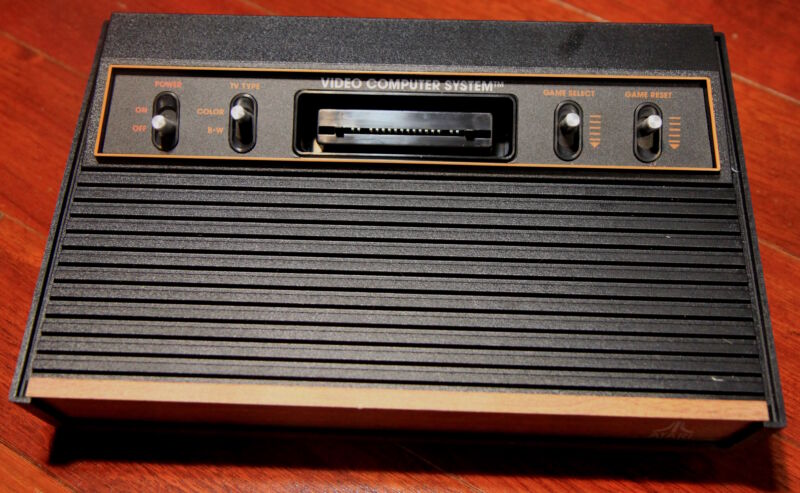
Unfortunately, that's about all this bare-bones, $130 hardware does. If you're expecting the kind of modern quality-of-life features you've seen on other retro console revamps in recent years, lower your expectations accordingly here.
A cute curio
Let's start with the physical hardware itself, which earns points for authenticity. At a glance, the 2600+ looks exactly like an Atari 2600 unit you might remember from decades past (albeit a four-switch "CX2600-A" model introduced in 1980, not one of the larger "Sixer" models from the late '70s). The fake wood grain and suitably springy front switches are sure to activate the nostalgia centers deep in the brains of gamers of a certain age. There's even a charming, working switch for flipping from Color to Black and White display, an option that hasn't been relevant to most living room entertainment centers since the Carter administration (at the latest).
-
The Atari 2600+ (top) seen next to an authentic "Heavy Sixer" unit from the '70s.Kyle Orland
-
The back of the unit shows the USB-C power input and HDMI output, as well as a switch between 16:9 and 4:3 aspect ratios.Kyle Orland
-
The 10-in-1 cartridge seen here is included in the packaging. The new Mr. Run and Jump is sold separately (and is kind of fun in a Pitfall sort of way).Kyle Orland
-
The back of the packaging.Kyle Orland
-
Switching games on that 10-in-1 cartridge involves flipping a bunch of tiny dip switches on the back.Kyle Orland
-
We were also sent an "Enhanced" version of Berzerk (left) which adds voice samples over the original cartridge (right).Kyle Orland
The only real "modernization" in the unit itself is found in the back panel, where the power input has been switched to USB-C and the output has been switched from an embedded RCA cable to an HDMI port. The Atari logo on the front now also lights up when the system powers on, a nice small touch that doesn't distract from the classic styling.
One word of warning, though: for most living room setups, you'll probably want to invest in some HDMI and USB power cords that are much longer than the basic 1.5 m lengths included in the Atari 2600+ box. That's because the Game Select and Game Reset buttons on the unit itself are key controls that you'll need close at hand when playing most games. The 1.5 m cable on the included joystick won't let you stray very far from the base unit, anyway, especially when you account for the fact that the system's controller parts are authentically (but annoyingly) located on the back panel.

Speaking of that joystick, we couldn't find anything to differentiate the newly included "CX40+" model from the classic CX40 joystick you might remember from the original Atari 2600. During testing, in fact, the only real way I could tell the new joystick from an older model was by seeing a slightly different arrangement of screws on the bottom of the base. Other than that, this is the same stiff, hand-cramping, eight-direction, one-button design that Atari made famous decades ago. The new controller even works perfectly well when plugged into an original Atari 2600 unit (and vice versa for an old controller into the new 2600+).
One more word of warning, though; the base system doesn't come with a second controller, even though a whole lot of Atari games are pretty explicitly designed to be better with two simultaneous players. If you don't have an extra 2600 joystick controller lying around (and really, why don't you?), Atari will sell you a brand-new one for $25. And while a Genesis controller will fit in the slot (and work on original hardware), it won't work on the Atari 2600+, for some reason.
reader comments
216